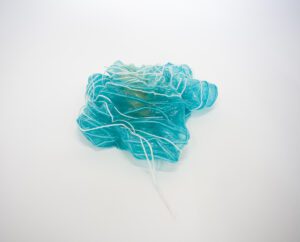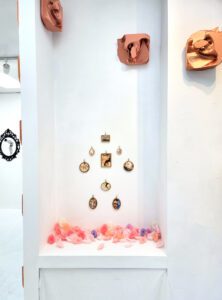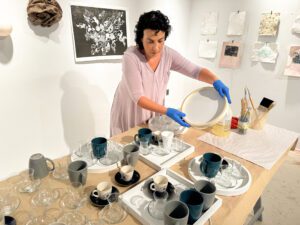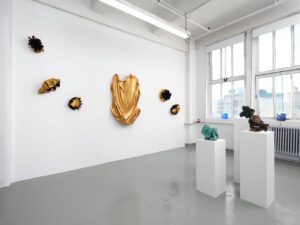When a video of Cynthia Nixon reading Camille Rainville’s poem “Be a Lady They Said” — featuring a jarring soundtrack by Louis Souyave against a back-drop of clips and stills of glamorous women from films and fashion shoots — was released in 2018, people went wild.
Making it prescient, these drop-dead gorgeous women were spliced with images from political reporting, the front pages of tabloids, and events that have come to characterize the #MeToo movement and other feminist struggles of our time (from a tummy tuck and Alexandra Ocasia-Cortez speaking to congress, to rapist and sex criminal *shuddering* Harvey Weinstein).
As Nixon narrates, “Men don’t like sluts” a clip of the pope greeting a woman in a crowd flickered on my screen — the pope certainly does not like sluts, or “artificial” birth control, a major tool to facilitate their safety. Kudos to British fashion photographer Claire Rothstein who adapted the 2017 poem to a short-film.

Now, an exhibition at Space776 — a Korean gallery with a New York outpost — presents work where curator Erica Criss has used the same poem as a curatorial tool to frame sculptures by Lesley Bodzy and tapestries by Katie Commodore. Moreover, they all deal with core issues of the feminist movement — beauty and sex.
“Feminist work like this is still relevant because these narratives still exist. Both Bodzy and Commodore’s work are inspired by their lived experiences. The fact that they are a generation apart, from different backgrounds, and are tackling the same themes shows us that it has always been relevant,” curator Criss commented on the importance of the show’s themes.

The deflated balloons of Bodzy’s “FOGO” also speak to the beauty industry that Rainville critiques in her poem. The artist has coated the yellow, turquoise, and red deflated balloons in resin to preserve their shape as they are installed one below the other. Because what can happen to breasts as they age? They can deflate slightly.
But in my opinion, these works are ironic because what breast starts plump like a blown-up balloon and then deflates completely with time? None. All women are at various stages of deflation after (even during) puberty — not all breasts are super perky.
The turquoise one even has strands on it, like hairs. A pink one closer to the door is larger and more uneven. I think Bodzy has chosen stark colors to show that all breasts, skin, and body parts can be eye-catching, appealing, and fun despite their form and age.
The three large woven tapestries — Carly, Julia, and Erin (DIY) — that Commodore has bedazzled with rhinestones and embroidery are stunning. They are installed on rods, hanging a few inches off the wall, and they look great. These women lounging around looking sexy and cheeky are all, as the press release states, the artist’s friends.
Mickalene Thomas paints large-scale portraits of black women she knows in pattern-heavy interiors. Commodore takes this a step further by photographing her female friends in their underwear, feeling sexy, then painting them and sending the painting out to be digitally rendered and woven.
Unlike Rothstein’s produced shoots, Commodore’s portraits are intimate and home-y, recalling knitting and BDSM — normal pastimes that spark joy. The artist has framed many of the works in fanciful black frames, leaning into the concept of “ornamentation” and the “decorative,” previously a pejorative term to describe the applied arts, including textiles.
As an example of Modernism’s disparaging views of the “decorative” and blatant disregard for the work of women, Russian author Leo Tolstoy wrote in 1989: “Real art, like the wife of an affectionate husband, needs no ornaments, but counterfeit art, like a prostitute, must always be decked out.” Commodore’s work proves progress in the integration of “high and low art” and that their distinctions should be left in the past.

The exhibition is hung salon-style, meaning works are staggered both below and above eye level. The groupings, like conversations, chart the artists’ material experimentation over time; Criss met Bodzy three years ago after she completed her large gold sculpture series “Soft Embrace,” some on view in the show, and was “instantly drawn to her unique process and how she was using materials.” Her work inspired the show, she continues: “The more we talked about her work, the more we connected over her strong feminist themes. It was these conversations that inspired this show.”
Criss met Commodore six years ago when she was working at a non-profit fine art print shop in Midtown Manhattan: “She was making etchings and screenprints during that time, so my introduction to her was as a printmaker. I soon came to learn the depth of her talent as a multimedia artist, as you will see in this show, from her large embroideries to her miniature watercolor portraits.”

Criss, also an artist, has made good use of the rather petite space’s architectural elements. The alcove presents a shrine-like hanging with Commodore’s 3-inch framed tondo (round) paintings hanging like Orthodox icons as if capturing the “spirit of womanhood.” Women and their body parts are depicted in various poses (I omitted the word suggestive for its disparaging connotation). On the ledge at chest level, Bodzy’s silicone ears from her “Hearsay” series are scattered — the rumor mill is ready to attack (probably using words like suggestive).
The collection of works is inherently accepting. Bodzy’s work “Goddess,” for instance, nods to plastic surgery with its visible seam uniting silicone, balloon, and lace — as a celebration.
Criss comments: “Change begins with conversations. My intention with this exhibition was to inspire women to come together and share their stories and begin to re-write the narratives from their perspectives.”
One more thing: the ears from Bodzy’s “Hearsay” series are on sale for $50, which, as a gal who has written about collecting art on a budget, I love.
“Womanhood 102” is on view through June 8 at Space 776, 37-39 Clinton St., 1st Fl., New York, NY 10002.








